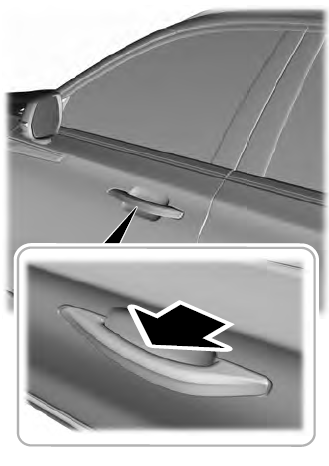Lincoln Aviator: Rear Drive Halfshafts / Removal and Installation - Rear Halfshaft
Removal
NOTICE: Never pick up or hold the halfshaft by only the inner or outer CV joint. Damage to the CV joint will occur.
NOTICE: Never use a hammer to remove or install the halfshafts. Damage to the CV joint may occur.
NOTICE: Never use the halfshaft assembly as a lever to position other components. Damage to the halfshaft or CV joint may occur.
mostbet free spinsNOTICE: Do not allow the boots to contact sharp edges or hot exhaust components. Damage to the halfshaft boots will occur.
NOTICE: Do not drop assembled halfshafts. The impact may cut the boots from the inside without evidence of external damage.
NOTE: LH shown RH similar.
-
Remove the wheel knuckle.
Refer to: Wheel Knuckle (204-02 Rear Suspension, Removal and Installation).
-
Using a pry bar, remove the halfshaft.
.jpg) |
-
Remove and discard the inner halfshaft circlip.
.jpg) |
-
Clean and inspect the inner halfshaft seal surface and splines for damage.
.jpg) |
-
Clean and inspect the outer CV (constant velocity) housing at the shown locations.
.jpg) |
Installation
NOTE: LH shown RH similar.
-
NOTE: The halfshaft seal has to be replaced whenever the halfshaft is removed.
Replace the halfshaft seal.
Refer to: Rear Halfshaft Seal (205-02 Rear Drive Axle/Differential, Removal and Installation).
-
Install a new inner halfshaft circlip.
.jpg) |
-
NOTICE: After insertion, pull the halfshaft inner end to make sure the circlip is locked.
NOTE: Make sure that the circlip opening is located at the bottom or 6 o'clock position to allow easy halfshaft installation.
NOTE: When seated correctly, the halfshaft retainer circlip can be felt as it snaps into the differential side gear groove.
Install the halfshaft until the halfshaft circlip is fully seated.
.jpg) |
-
Install the wheel knuckle.
Refer to: Wheel Knuckle (204-02 Rear Suspension, Removal and Installation).
-
Check and top off the rear differential fluid.
Refer to: Differential Fluid Level Check (205-02 Rear Drive Axle/Differential, General Procedures).
 Diagnosis and Testing - Rear Drive Halfshafts
Diagnosis and Testing - Rear Drive Halfshafts
Preliminary Inspection
Visually inspect the CV joints, housing, boots, and clamps for obvious signs of mechanical damage.
If an obvious cause for an observed or reported concern is
found, correct the cause (if possible) before proceeding to the next
step
If the cause is not visually evident, verify the symptom and REFER to Symptom Chart: NVH...
 Brake System
Brake System
..
Other information:
Lincoln Aviator 2020-2025 Service Manual: Removal and Installation - Front Seat Cushion Adjuster - Vehicles With: Multi-Contour Seats
Removal NOTE: Driver seat shown, passenger seat similar. Remove the front seat cushion cover. Refer to: Front Seat Cushion Cover - Vehicles With: Multi-Contour Seats (501-10A Front Seats, Removal and Installation). Cushion adjuster Remove the front seat cushion blower motor...
Lincoln Aviator 2020-2025 Owners Manual: Information Messages
..
Categories
- Manuals Home
- Lincoln Aviator Owners Manual
- Lincoln Aviator Service Manual
- Description and Operation - Jacking and Lifting
- Body and Paint
- Description and Operation - Body and Frame
- New on site
- Most important about car
Activating Intelligent Access
The intelligent access key must be within 3 ft (1 m) of the door or luggage compartment you intend to lock or unlock.
At a Door
Electronic door handles are on each door. Gently depress the switch inside the exterior door handle to unlock and open the door. An unlock symbol illuminates on the door window trim indicating your vehicle is unlocked.

